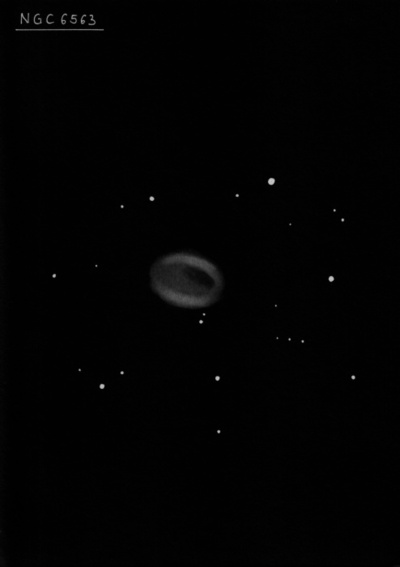
John Herschel discovered NGC 6563 = h3734 = D 606? on 7 Jun 1837 and recorded "a L, F, oval, planetary nebula, about 60" long, 50" broad, or 55"; considerably hazy, or rather indistinctly terminated at the borders, but not bM; a star 6-7m precedes it, just 1 diameter of the field and nearly in the parallel."
James Dunlop possibly discovered this planetary on 3 Sep 1826 and reported a "faint nebula, about 1 1/4' long and 30" or 40" broad, with a considerable brightness near each end and faint in the middle, resembling two small nebulae joined." His position (single observation) is 36' northeast of NGC 6563. This is a fairly large error, even for Dunlop, but the size is reasonably close.
Joseph Turner sketched the planetary on 30 Jul 1877 with the Great Melbourne Telescope as an oval and "a close double star just touches its south edge."
Based on Crossley photographs at Lick, Curtis (1918) reported NGC 6565 as "a faint oval 50"x37" in p.a. 50°; stronger regions at the ends of the minor axis give it an indistinct ring or shell effect; it is considerably fainter along, and at the ends of the major axis."
200/250mm - 8" (7/16/82): faint, elongated N-S, fairly small.
300/350mm - 13" (8/17/85): observation at 166x and 220x: fairly faint, moderately large, slightly elongated ~N-S, no annularity. Prominent using UHC filter, moderate surface brightness. Located in a rich star field 15' ESE of mag 6.2 SAO 209817.
400/500mm - 17.5" (6/28/00): at 280x this moderately bright PN appears elongated 5:4 SW-NE, ~50"x40". The surface brightness is pretty smooth and no central star was visible. A UHC filter provides a moderate contrast gain. Set is a rich star field.
600/800mm - 24" (7/11/18): at 200x and NPB filter; bright, moderately large, slightly elongated SW-NE, ~50" diameter, crisp-edged, irregular surface brightness, weakly annular, resides in a rich star field. At 375x the elongation was more evident as well as a noticeably irregular surface brightness with slightly darker interior areas. A faint star is at the SSW edge and one or two extremely faint stars seemed to be superimposed.
Notes by Steve Gottlieb